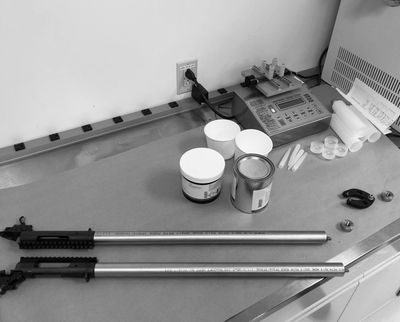Signed in as:
filler@godaddy.com
Signed in as:
filler@godaddy.com

Testing a unique and patented technology applied to the length of a gun barrel and encased in carbon fiber has produced significant improvements in weapon accuracy. In addition, it's lightweight and void of moving parts or power requirements. Also referred to as constrained-layer damping, this cladding combined with our proprietary resin reduces tangential barrel acceleration and enhances precision and stability.
Approximately 30% of the energy produced enters the gun barrel as noise during firing. The noise circulates multiple times within the length of the barrel before the projectile exits the muzzle. The barrel distorts in response to this energy. Since the boundary - defined by the barrel's steel and the air outside of the barrel - acts as a near-perfect reflector trapping the energy within the barrel, it causes chaotic disturbance of the muzzle and degrades accuracy. Numerous interdependent variables affect the nature of the disturbance, making them difficult to control.
The addition of a temperature-tolerant elastomeric resin to the barrel - which extends from the chamber to the muzzle and is covered entirely by a carbon fiber shroud - has been proven to reduce noise-induced barrel movements. Constrained-layer damping converts vibrations in the barrel to heat through the shearing of the constrained layer's elastomer. Extensive testing also proves this advanced weapon technology will withstand normal barrel temperatures. In addition, the resin's formula will endure harsh battlefield environments while adding trivial weight to the weapon.
With more than 20 prototypes and more than 6,000 rounds fired, Radial Mean Dispersion improved from 30% to more than 50%. Testing a 20-gauge smoothbore shotgun firing high-velocity, sub-caliber sabots demonstrated a 31% improvement in circular error probability and a 41% reduction in standard deviation. Additionally, the data revealed a 53% improvement in sabot stability. This implies an increase in long-rod penetrator performance, especially at farther ranges.
Since a tank cannon operates at much higher powers and vibration levels than small arms, Dreadnought™ technology can produce even more significant improvements for tank weaponry. Furthermore, a decrease in tangential barrel displacements can reduce failure of the long-rod penetrator as a result of the barrel-induced projectile yaw.
By clicking "Accept All Cookies", you agree to the storing of cookies on your device to enhance site navigation, analyze site usage, and assist in our marketing efforts.